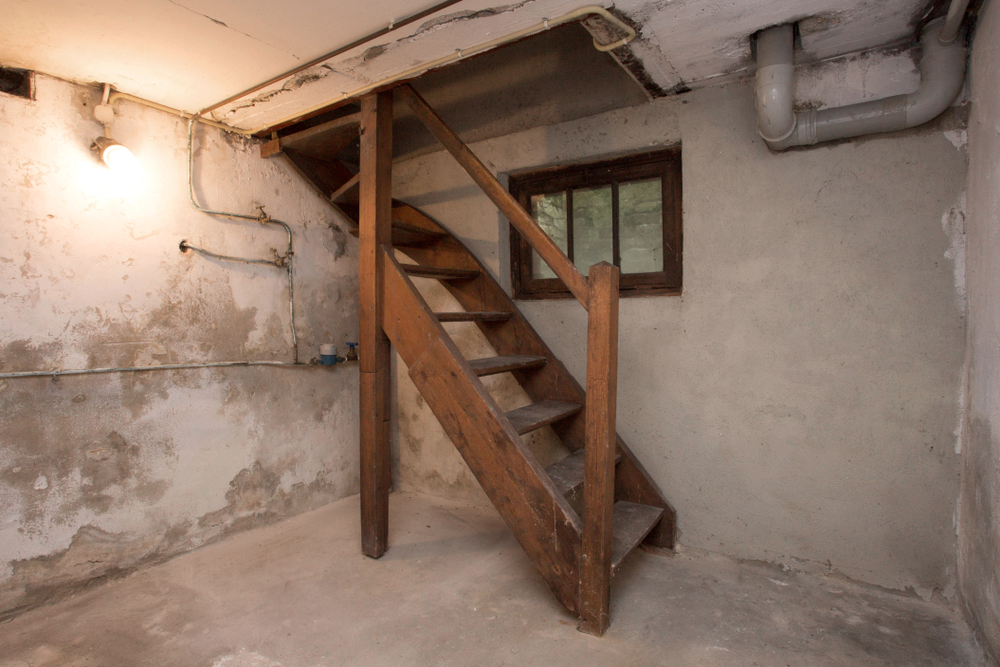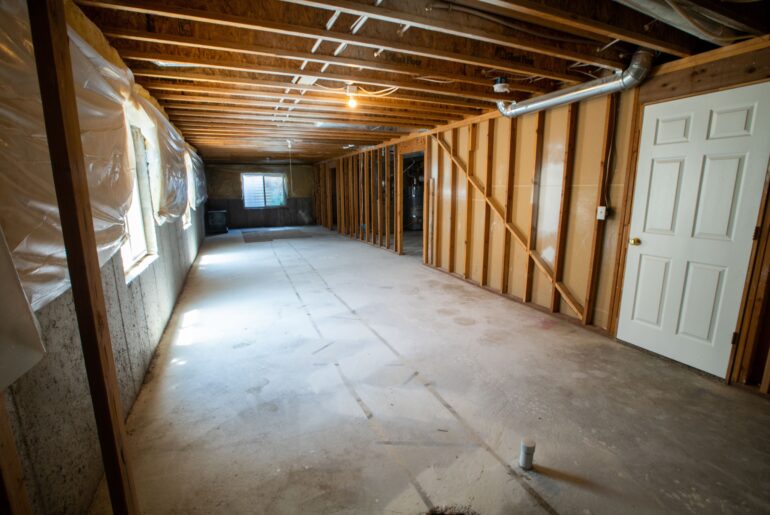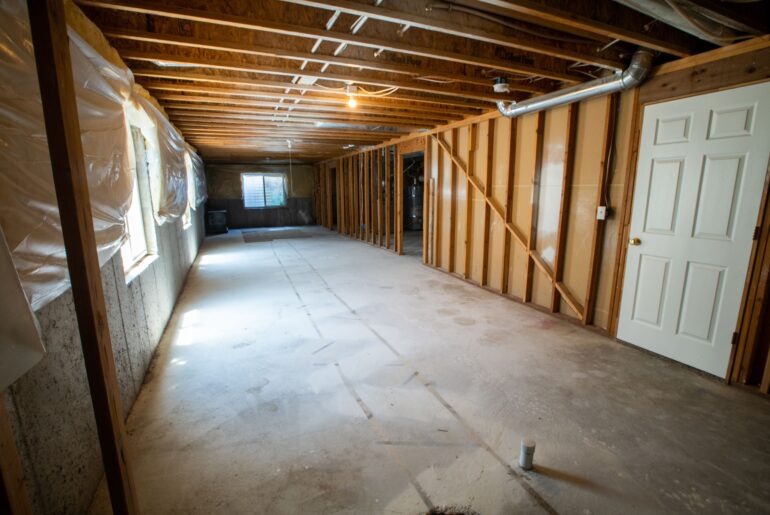Mold needs three things to thrive in your basement, and they are simply moisture, a food source, and an ambient temperature between 40°F and 100°F to give it perfect conditions.
Basements with poor ventilation and high moisture levels are a breeding ground for mold, which can contribute to a number of health conditions. If you suffer from asthma, chronic obstructive pulmonary disease (COPD) or are immunocompromised, you are at risk.
Add to that the negative effects that certain strains of mold can have on the structural elements of the basement, and it soon becomes clear that it cannot be ignored.
So, what are your options when it comes to preventing mold from thriving in your basement?
Option 1. Closed Cell Spray Foam Insulation
This is an expanding foam product made from isocyanate mixed with polyurethane at the nozzle, which delivers a high R-value within a depth of two inches. Usually fitted by professional teams there are a number of DIY kits on the market for the experienced home renovator.
Closed cell spray foam insulation is currently the best option for basement wall insulation as it not only creates a vapor barrier, but it also has a very high R-value of 7/inch. Yes, it is also the most expensive option, but it will seal your concrete and concrete block walls such that no moisture will get through and into the conditioned space of your basement.
It is worth considering that with closed cell spray foam there is no need to put in an additional vapor barrier, which would require sealing with tape and may be vulnerable to penetration. Also, it is excellent for insulating those difficult to reach areas such as the rim joist that runs right around the house.
The application of closed cell spray foam will mean that the basement has a much better chance of staying dry even when the grading outside the building becomes saturated due to heavy rain or snowfall.
Closed cell spray foam bonds well to clean, dry, porous surfaces, which means that it cannot be installed over wet areas, or areas already subject to mold growth. It makes this insulation perfect for basements that have already had remedial repair works already carried out. It is ideal cost-wise if you are likely to remain in the property for the long term, thereby mitigating the initial outlay against the energy savings made.
Keep in mind the fact that it is recommended that during a closed cell spray foam insulation installation the property should be left unoccupied for at least 24 hours after completion to allow for any off-gassing to dissipate.
Set your wall studs an inch from the basement walls to ensure the spray foam can be installed continuously on the concrete basement walls.
Make sure all essential services such as taps, switches, lights, electrical outlets, dials, or other functioning items are properly protected prior to installation as spray foam can be a messy job. Oftentimes the preparation for spray foam can take longer than the actual installation.
Do not confuse closed cell spray foam with its cousin Open Cell Spray Foam, which can retain water and so is not suitable for insulating areas that are exposed to high humidity or moisture levels.
Option 2. Rigid Foam Board Insulation
Rigid foam board insulation comes in three main forms, expanded polystyrene, extruded Styrofoam or polyiso board, which is usually backed with a reflective silver material. All three iterations are light to handle and easy to cut and fit and have good R-values.
The very best way to install rigid foam board insulation in the basement is direct to the wall. Sealed top and bottom with spray foam and glued and taped at the joints you might think that this should be enough to prevent water vapor from migrating through from the outside to the dryer interior of the basement.
It is, as long as the foam board used is at least two inches thick, with an R-value high enough to ensure a positive thermal break such that moisture does not condense on the surface of the foam board.
If you are putting up a stud wall and want to infill between the wall studs, calculating the R-value of the timber as part of the overall insulating strategy, then you will need to fit a vapor barrier across the entire wall. Sealing the foam board against the timber wall studs is difficult, but necessary to ensure a completely insulated wall.
Foam board can be used in conjunction with other insulation products to balance cost and practicality, i.e. using foam board directly on the wall with rockwool batts between the studs is a practical way to ensure the R-value you require in your particular climate zone is met.
Keep in mind that different rigid foam boards have different properties and so some products may need to be thicker in order to produce the effect required. For example, polystyrene, while being an excellent insulator, is also a rather fragile material, prone to cracking and will break if put under too much pressure.
Option 3. Rockwool Batts
Rockwool batts are a spun mineral fiber insulation that is cost effective with a good R-value. It is water repellent while being vapor permeable, which means its natural drying potential makes it resistant to mold growth.
It has a high fire safety rating making it a safe choice for a basement that may have any number of appliances installed. Its dimensional stability also means that you can be confident that it will not degrade significantly over the longer term.
If you choose to install rockwool batts then it is advisable to fit a proprietary house wrap paper from just above the grade line to the floor under the baseboard for the wall framing, to allow any moisture moving through the foundation walls to escape back through the masonry to the exterior.
The best way to install mineral wool insulation batts is to fit them in two layers. Lay them horizontally between the wall and the wall studs and fit a second layer vertically between the wall studs with mechanical fasteners or by using compression. Using a proprietary construction adhesive, with a rapid grab, fit a vapor barrier direct to the wall studs before lining out with drywall.
The vapor barrier must be over-lapped and folded at every joint and corner to ensure full integrity of the system. If the vapor barrier is installed horizontally, for instance, then the lower course must be installed first while the upper course must overlap such that any condensation does not collect behind the vapor barrier.
Do not confuse rockwool batts for fiberglass, which does not have the same stable structure, will retain moisture, and make mold problems worse.
How to Avoid Mold in Basement Insulation
A note on getting the basics right to prevent mold in your basement:
- Make sure that all gutters and downpipes are clear and in good condition and that all rainwater is discharged away from the house.
- Check that the grading to the exterior of the house is running the right way, i.e. away from the house.
- Make sure that all internal plumbing is in good condition and that there are no leaks within the basement.
- Ensure any vents or penetrations to the exterior are either properly sealed or in good working order.
- Make good all masonry or mold affected timber before carrying out any insulation work. You may need to use a dehumidifier to reduce moisture levels but be aware that a dehumidifier will only alleviate the symptoms and not deal with the underlying causes of mold.
- Do not install insulation over existing leaks, dampness, efflorescence, or peeling, flaking paint or crumbling mortar.
- Studies have shown that up to 19% of a home’s heat energy can be lost through a poorly insulated rim joist, so whatever system you choose, giving this area special attention will always pay dividends.
- On a new-build project your architect will likely recommend insulating the external walls of the basement prior to grading.





